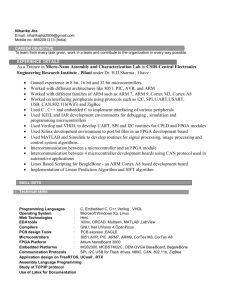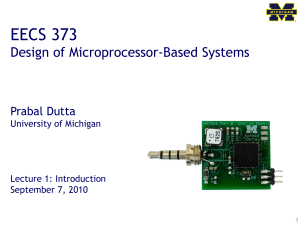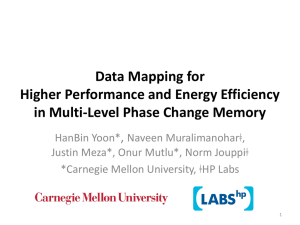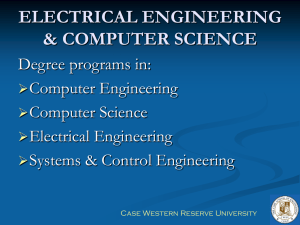1 - University of Michigan
advertisement
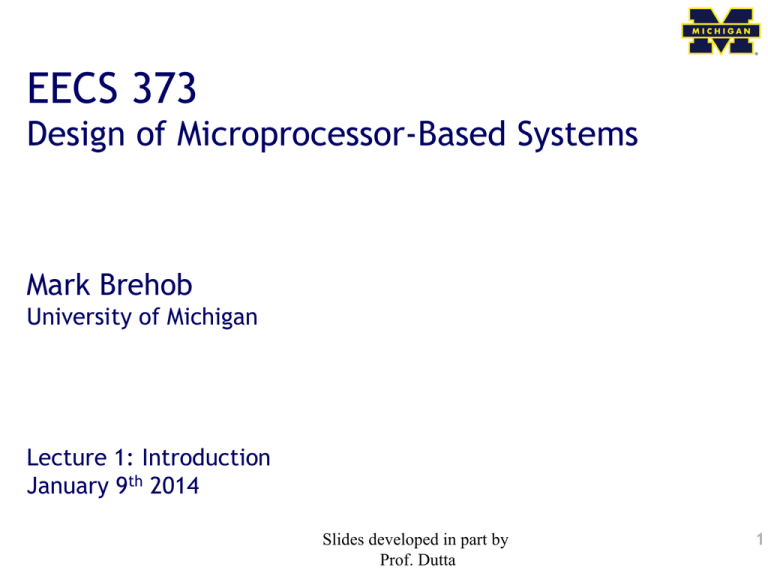
EECS 373 Design of Microprocessor-Based Systems Mark Brehob University of Michigan Lecture 1: Introduction January 9th 2014 Slides developed in part by Prof. Dutta 1 Folks • Dr. Mark Brehob – Lecturer (full-time teacher) in EECS – My background is on the embedded systems and architecture side • Matt Smith – Head lab instructor – Been doing 373 for more than 10 years! • IAs: – Jason Shintani Richard Ortman Ronak Mehta Ryan McMahon 2 What is an embedded system? 3 Embedded, everywhere 4 Embedded, Everywhere - Fitbit 5 What is driving the embedded everywhere explosion? 6 Outline Technology Trends Course Description/Overview Tools Overview/ISA start 7 log (people per computer) Bell’s Law of Computer Classes: A new computing class roughly every decade Number Crunching Data Storage Mainframe Minicomputer productivity interactive Workstation PC Laptop PDA year “Roughly every decade a new, lower priced computer class forms based on a new programming platform, network, and interface resulting in new usage and the establishment of a new industry.” streaming information to/from physical world Adapted from D. Culler 8 Moore’s Law: IC transistor count doubles every two years Photo Credit: Intel 9 Flash memory scaling: Rise of density & volumes; Fall (and rise) of prices 10 Hendy’s “Law”: Pixels per dollar doubles annually Credit: Barry Hendy/Wikipedia 11 MEMS Accelerometers: Rapidly falling price and power O(mA) 25 µA @ 25 Hz ADXL345 [Analog Devices, 2009] 10 µA @ 10 Hz @ 6 bits [ST Microelectronics, annc. 2009] 12 MEMS Accelerometer in 2012 1.8 µA @ 100 Hz @ 2V supply! ADXL362 [Analog Devices, 2012] 13 MEMS Gyroscope Chip J. Seeger, X. Jiang, and B. Boser 14 Energy harvesting and storage: Small doesn’t mean powerless… RF [Intel] Thin-film batteries Piezoelectric [Holst/IMEC] Clare Solar Cell Shock Energy Harvesting CEDRAT Technologies Electrostatic Energy Harvester [ICL] Thermoelectric Ambient Energy Harvester [PNNL] 15 Bell’s Law, Take 2: Corollary to the Laws of Scale ~100 Watts UMich Phoenix Processor Introduced 2008 Initial clock speed ~0.1 Watt? Photo credits: Intel, U. Michigan 106 kHz @ 0.5V Vdd Number of transistors 92,499 ~30pW Watts? Manufacturing technology 0.18 µ 16 Why study 32-bit MCUs and FPGAs? 17 MCU-32 and PLDs are tied in embedded market share 18 What differentiates these products from one another? FPGA ===== Microprocessor ============= 19 What differentiates these products from one another? 20 The difference is… Peripherals Peripherals Peripherals 21 Why study the ARM architecture (and the Cortex-M3 in particular)? 22 Lots of manufacturers ship ARM products 23 ARM is the big player • ARM has a huge market share – As of 2011 ARM has chips in about 90% of the world’s mobile handsets – As of 2010 ARM has chips in 95% of the smartphone market, 10% of the notebook market • Expected to hit 40% of the notebook market in 2015. – Heavy use in general embedded systems. • Cheap to use – ARM appears to get an average of 8¢ per device (averaged over cheap and expensive chips). • Flexible – Spin your own designs. 24 Outline Technology Trends Course Description/Overview Tools Overview/ISA start 25 Course goals • Learn to implement embedded systems including hardware/software interfacing. • Learn to design embedded systems and how to think about embedded software and hardware. • Have the opportunity to design and build nontrivial projects involving both hardware and software. 26 Prerequisites • EECS 270: Introduction to Logic Design – Combinational and sequential logic design – Logic minimization, propagation delays, timing • EECS 280: Programming and Intro Data Structures – C programming – Algorithms (e.g. sort) and data structures (e.g. lists) • EECS 370: Introduction to Computer Organization – Basic computer architecture – CPU control/datapath, memory, I/O – Compiler, assembler 27 Topics • Memory-mapped I/O – The idea of using memory addressed to talk to input and output devices. • Switches, LEDs, hard drives, keyboards, motors • Interrupts – How to get the processor to become “event driven” and react to things as they happen. • Working with Analog inputs – The real world isn’t digital! • Common devices and interfaces – Serial buses, timers, etc. 28 Example: Memory-mapped I/O • This is important. – – It means our software can tell the hardware what to do. • In lab 3 you’ll design hardware on an FPGA which will can control a motor. – But more importantly, that hardware will be designed so the software can tell the hardware exactly what to do with the motor. All by simply writing to certain memory locations! In the same way, the software can read memory locations to access data from sensors etc… 29 Grades Item ====== Labs (7) Project Exams HW /Guest talks Oral presentation Weight ========= 25% 25% 40% (20% midterm; 20% final) 6% 4% • Project and Exams tend to be the major differentiators. • Class median is generally a low B+. 30 Time • You’ll need to assume you are going to spend a lot of time in this class. – 2-3 hours/week in lecture (we cancel a few classes during project time) – 8-12 hours/week working in lab • Expect more during project time; some labs are a bit shorter. – ~20 hours (total) working on homework – ~20 hours (total) studying for exams. – ~8 hour (total) on your oral presentation • Averages out to about 15-20 hours/week preproject and about 20 during the project… – This is more than I’d like, but we’ve chosen to go with state-of-the-art tools, and those generally have a heck of a learning curve. 31 Labs • 7 labs, 8 weeks, groups of 2 1. 2. 3. 4. 5. 6. 7. FPGA + Hardware Tools MCU + Software Tools Memory + Memory-Mapped I/O Interrupts Timers and Counters Serial Bus Interfacing Data Converters (e.g. ADCs/DACs) • Labs are very time consuming. – As noted, students estimated 8-12 hours per lab with one lab (which varied by group) taking longer. 32 Open-Ended Project • Goal: learn how to build embedded systems – By building an embedded system – Work in teams of 2 to 4 – You design your own project • The major focus of the last third of the class. – Labs will be done and we will cancel some lectures and generally try to keep you focused. • Important to start early. – After all the effort in the labs, it’s tempting to slack for a bit. The best projects are those that get going right away. 33 Homework • 4-6 assignments – A few “mini” assignments • Mainly to get you up to speed on lab topics – A few “standard” assignments • Hit material we can’t do in lab. • Also a small part is for showing up to guest lecturers 34 Looking for me? • All office/lab hours are shared with EECS 470. – Monday 10-noon -- 4632 Beyster – Tuesday 3:30-5:00pm -- EECS 2334 (our lab) – Thursday 10:30-noon -- 4632 Beyster 35 Outline Technology Trends Course Description/Overview Tools overview/ISA start 36 We are using Actel’s SmartFusion Evaluation Kit 37 A2F200M3F-FGG484ES – – • • • • 200,000 System FPGA gates, 256 KB flash memory, 64 KB SRAM, and additional distributed SRAM in the FPGA fabric and external memory controller Peripherals include Ethernet, DMAs, I2Cs, UARTs, timers, ADCs, DACs and additional analog resources USB connection for programming and debug from Actel's design tools USB to UART connection to UART_0 for HyperTerminal examples 10/100 Ethernet interface with on-chip MAC and external PHY Mixed-signal header for daughter card support 38 FPGA work 39 “Smart Design” configurator 40 Eclipse-based “Actel SoftConsole IDE” 41 Debugger is GDB-based. Includes command line. Works really quite well. 42 ARM ISA 43 Major elements of an Instruction Set Architecture (registers, memory, word size, endianess, conditions, instructions, addressing modes) 32-bits 32-bits mov r0, #1 ld r1, [r0,#5] r1=mem((r0)+5) bne loop subs r2, #1 Endianess Endianess 44 The endianess religious war: 284 years and counting! • Modern version – – – – Danny Cohen IEEE Computer, v14, #10 Published in 1981 Satire on CS religious war • Historical Inspiration – – – – Jonathan Swift Gulliver's Travels Published in 1726 Satire on Henry-VIII’s split with the Church • Now a major motion picture! • Little-Endian – LSB is at lower address uint8_t a uint8_t b uint16_t c uint32_t d = = = = 1; 2; 255; // 0x00FF 0x12345678; Memory Offset ====== 0x0000 Value (LSB) (MSB) =========== 01 02 FF 00 0x0004 78 56 34 12 • Big-Endian – MSB is at lower address uint8_t a uint8_t b uint16_t c uint32_t d = = = = 1; 2; 255; // 0x00FF 0x12345678; Memory Offset ====== 0x0000 Value (LSB) (MSB) =========== 01 02 00 FF 0x0004 12 34 56 78 45 Addressing: Big Endian vs Little Endian (370 slide) • Endian-ness: ordering of bytes within a word – Little - increasing numeric significance with increasing memory addresses – Big – The opposite, most significant byte first – MIPS is big endian, x86 is little endian Instruction encoding • Instructions are encoded in machine language opcodes • Sometimes – Necessary to hand generate opcodes – Necessary to verify assembled code is correct • How? Instructions movs r0, #10 ARMv7 ARM movs r1, #0 Register Value Memory Value 001|00|000|00001010 (LSB) (MSB) (msb) (lsb) 0a 20 00 21 001|00|001|00000000 Assembly example data: .byte 0x12, 20, 0x20, -1 func: mov r0, #0 mov r4, #0 movw r1, #:lower16:data movt r1, #:upper16:data top: ldrb r2, [r1],1 add r4, r4, r2 add r0, r0, #1 cmp r0, #4 bne top 48 Instructions used • mov – Moves data from register or immediate. – Or also from shifted register or immediate! • the mov assembly instruction maps to a bunch of different encodings! – If immediate it might be a 16-bit or 32-bit instruction. • Not all values possible • why? • movw – Actually an alias to mov. • “w” is “wide” • hints at 16-bit immediate. 49 From the ARMv7-M Architecture Reference Manual (posted on the website under references) There are similar entries for move immediate, move shifted (which actually maps to different instructions) etc. 50 Directives • #:lower16:data – What does that do? – Why? 51 52 Loads! • ldrb? • ldrsb? 53 So what does the program _do_? data: .byte 0x12, 20, 0x20, -1 func: mov r0, #0 mov r4, #0 movw r1, #:lower16:data movt r1, #:upper16:data top: ldrb r2, [r1],1 add r4, r4, r2 add r0, r0, #1 cmp r0, #4 bne top 54 Questions? Comments? Discussion? 55
